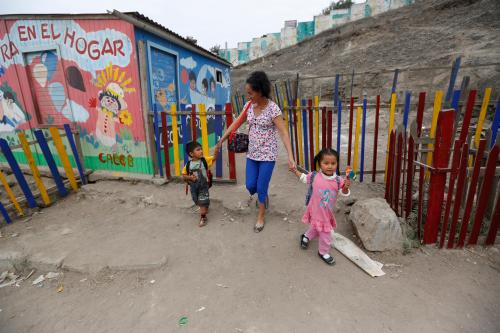Editor’s Note: This blog post is one in a series of posts in which guest bloggers respond to the Brookings paper, “The potential and limitations of impact bonds: Lessons from the first five years of experience worldwide.”
Constitutional mandate for ECD in Kenya
In 2014, clause 5 (1) of the County Early Childhood Education Bill 2014 declared free and compulsory early childhood education a right for all children in Kenya. Early childhood education (ECE) in Kenya has historically been located outside of the realm of government and placed under the purview of the community, religious institutions, and the private sector. The disparate and unstructured nature of ECE in the country has led to a proliferation of unregistered informal schools particularly in underprivileged communities. Most of these schools still charge relatively high fees and ancillary costs yet largely offer poor quality of education. Children from these preschools have poor cognitive development and inadequate school readiness upon entry into primary school.
Task to the county government
The Kenyan constitution places the responsibility and mandate of providing free, compulsory, and quality ECE on the county governments. It is an onerous challenge for these sub-national governments in taking on a large-scale critical function that has until now principally existed outside of government.
In Nairobi City County, out of over 250,000 ECE eligible children, only about 12,000 attend public preschools. Except for one or two notable public preschools, most have a poor reputation with parents. Due to limited access and demand for quality, the majority of Nairobi’s preschool eligible children are enrolled in private and informal schools. A recent study of the Mukuru slum of Nairobi shows that over 80 percent of 4- and 5-year-olds in this large slum area are enrolled in preschool, with 94 percent of them attending informal private schools.
In early 2015, the Governor of Nairobi City County, Dr. Evans Kidero, commissioned a taskforce to look into factors affecting access, equity, and quality of education in the county. The taskforce identified significant constraints including human capital and capacity gaps, material and infrastructure deficiencies, management and systemic inefficiencies that have led to a steady deterioration of education in the city to a point where the county consistently underperforms relative to other less resourced counties.
Potential role of impact bonds
Nairobi City County now faces the challenge of designing and implementing a scalable model that will ensure access to quality early childhood education for all eligible children in the city by 2030. The sub-national government’s resources and implementation capacity are woefully inadequate to attain universal access in the near term, nor by the Sustainable Development Goal (SDG) deadline of 2030. However, there are potential opportunities to leverage emerging mechanisms for development financing to provide requisite resource additionality, private sector rigor, and performance management that will enable Nairobi to significantly advance the objective of ensuring ECE is available to all children in the county.
Social impact bonds (SIBs) are one form of innovative financing mechanism that have been used in developed countries to tap external resources to facilitate early childhood initiatives. This mechanism seeks to harness private finance to enable and support the implementation of social services. Government repays the investor contingent on the attainment of targeted outcomes. Where a donor agency is the outcomes funder instead of government, the mechanism is referred to as a development impact bond (DIB).
The recent Brookings study highlights some of the potential and limitations of impact bonds by researching in-depth the 38 impact bonds that had been contracted globally as of March, 2015. On the upside, the study shows that impact bonds have been successful in achieving a shift of government and service providers to outcomes. In addition, impact bonds have been able to foster collaboration among stakeholders including across levels of government, government agencies, and between the public and private sector. Another strength of impact bonds is their ability to build systems of monitoring and evaluation and establish processes of adaptive learning, both critical to achieving desirable ECD outcomes. On the downside, the report highlights some particular challenges and limitations of the impact bonds to date. These include the cost and complexity of putting the deals together, the need for appropriate legal and political environments and impact bonds’ inability thus far to demonstrate a large dent in the ever present challenge of achieving scale.
Challenges in implementing social impact bonds in Kenya
In the Kenyan context, especially at the sub-national level, there are two key challenges in implementing impact bonds.
To begin with, in the Kenyan context, the use of a SIB would invoke public-private partnership legislation, which prescribes highly stringent measures and extensive pre-qualification processes that are administered by the National Treasury and not at the county level. The complexity arises from the fact that SIBs constitute an inherent contingent liability to government as they expose it to fiscal risk resulting from a potential future public payment obligation to the private party in the project.
Another key challenge in a SIB is the fact that Government must pay for outcomes achieved and for often significant transaction costs, yet the SIB does not explicitly encompass financial additionality. Since government pays for outcomes in the end, the transaction costs and obligation to pay for outcomes could reduce interest from key decision-makers in government.
A modified model to deliver ECE in Nairobi City County
The above challenges notwithstanding, a combined approach of results-based financing and impact investing has high potential to mobilize both requisite resources and efficient capacity to deliver quality ECE in Nairobi City County. To establish an enabling foundation for the future inclusion of impact investing whilst beginning to address the immediate ECE challenge, Nairobi City County has designed and is in the process of rolling out a modified DIB. In this model, a pool of donor funds for education will be leveraged through the new Nairobi City County Education Trust (NCCET).
The model seeks to apply the basic principles of results-based financing, but in a structure adjusted to address aforementioned constraints. Whereas in the classical SIB and DIB mechanisms investors provide upfront capital and government and donors respectively repay the investment with a return for attained outcomes, the modified structure will incorporate only grant funding with no possibility for return of principal. Private service providers will be engaged to operate ECE centers, financed by the donor-funded NCCET. The operators will receive pre-set funding from the NCCET, but the county government will progressively absorb their costs as they achieve targeted outcomes, including salaries for top-performing teachers. As a result, high-performing providers will be able to make a small profit. The system is designed to incentivize teachers and progressively provide greater income for effective school operators, while enabling an ordered handover of funding responsibilities to government, thus providing for program sustainability.
Nairobi City County plans to build 97 new ECE centers, all of which are to be located in the slum areas. NCCET will complement this undertaking by structuring and implementing the new funding model to operationalize the schools. The structure aims to coordinate the actors involved in the program—donors, service providers, evaluators—whilst sensitizing and preparing government to engage the private sector in the provision of social services and the payment of outcomes thereof.





Commentary
Perspectives on Impact Bonds: Working around legal barriers to impact bonds in Kenya to facilitate non-state investment and results-based financing of non-state ECD providers
December 21, 2015